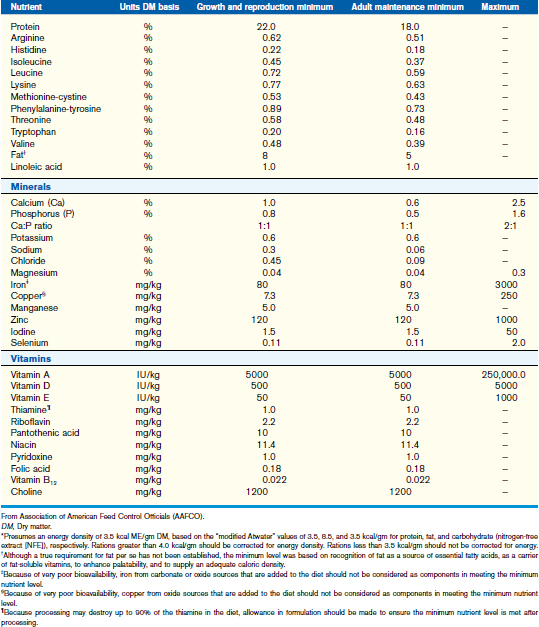CHAPTER 8 Nutritional Requirements and Feeding of Growing Puppies and Kittens
Milk Contents
A healthy mother who is well-nourished should be able to provide complete nutrition for a puppy or kitten for their first 4 weeks. A healthy puppy or kitten will nurse vigorously several times a day and gain weight on a daily basis. A malnourished puppy or kitten will fail to gain weight, constantly cry, and become inactive (see Chapter 11). More neonates die from improper husbandry and nutrition than disease. Birth weight is the single most important predictor of neonate survival. Average birth weight for toy, medium, large, and giant breed dogs can be found in Box 8-1.
Milk Replacer Requirements
If commercial milk replacer is temporarily unavailable, an emergency formula may be used (Box 8-2). This emergency formula is strictly for emergencies and should be replaced with a commercial milk formula as soon as possible.
American Feed Control Officials
The most commonly used unit of measurement is the kilocalorie (kcal), defined as the amount of heat necessary to raise the temperature of 1 kilogram (kg) of water by 1 degree Celsius. Calories are used to maintain physical activity, digestion, growth, and basal metabolism. Most foods are recommended in kilocalorie/8 oz cup of dry food or kilocalorie/can. Puppies and kittens require a larger amount of energy early in life, which decreases as they age. It is important to follow the feeding recommendations established by the pet food manufacturer, since diets vary by company, as well as within a specific product line. The AAFCO nutrient requirements for puppies and kittens are listed in Tables 8-1 and 8-2, respectively.
Stay updated, free articles. Join our Telegram channel

Full access? Get Clinical Tree


 weeks of age. The advantages of this earlier nutritional weaning in the opinion of some are preventing debilitation of the dam nursing a large litter and allowing the transitioning process of the GI tract to solid food while still under the protection of colostral antibodies. From the time of weaning until 6 months old (9 months in large-breed dogs), it is advised to feed juveniles three times a day and more frequently for smaller and toy breeds. Thereafter dogs and cats should be fed twice daily on a regular schedule.
weeks of age. The advantages of this earlier nutritional weaning in the opinion of some are preventing debilitation of the dam nursing a large litter and allowing the transitioning process of the GI tract to solid food while still under the protection of colostral antibodies. From the time of weaning until 6 months old (9 months in large-breed dogs), it is advised to feed juveniles three times a day and more frequently for smaller and toy breeds. Thereafter dogs and cats should be fed twice daily on a regular schedule.
